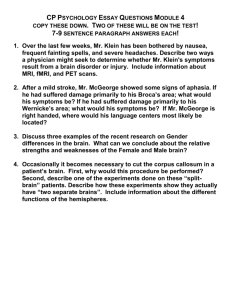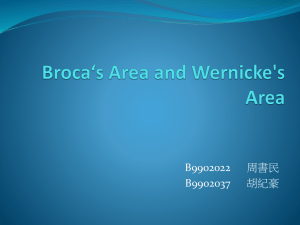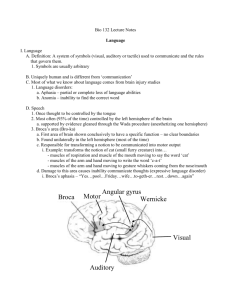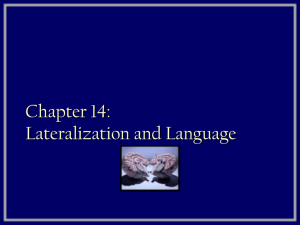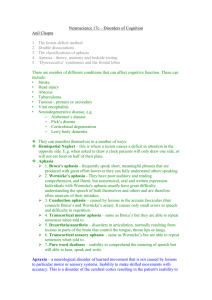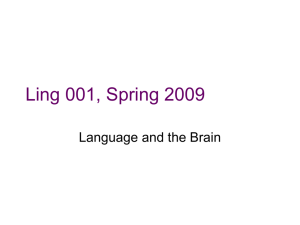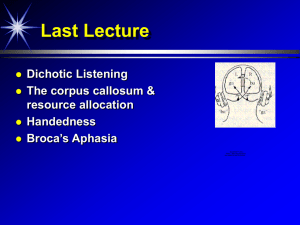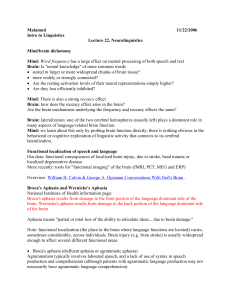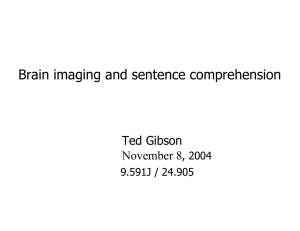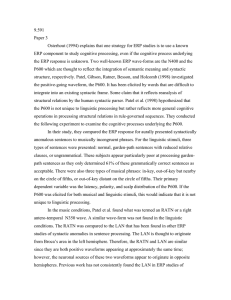Brain and Language: Adults (with extra notes)
advertisement
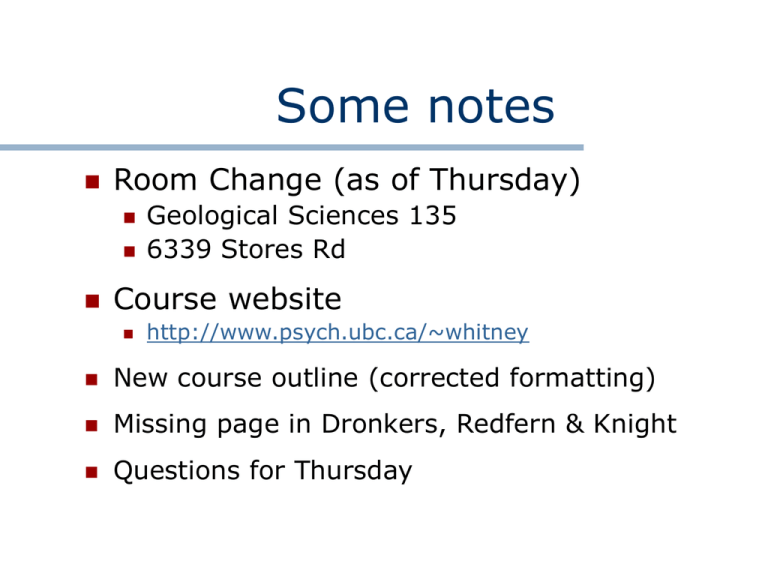
Some notes Room Change (as of Thursday) Geological Sciences 135 6339 Stores Rd Course website http://www.psych.ubc.ca/~whitney New course outline (corrected formatting) Missing page in Dronkers, Redfern & Knight Questions for Thursday Language & the Brain Adults Outline of Lecture Language & the brain: a history Gall, Broca, Wernicke, Lichtheim The classical model of aphasia Problems with the classical model Neuroimaging Focus on ERPs Franz Joseph Gall (late 1700’s) Phrenology: the linking of human characteristics with the relative size of skull areas Believed the language faculty to be located in the two frontal lobes Paul Broca (1861, 1865) Patient “Tan” Right hemiparesis and loss of speech Comprehension okay Brain viewed at autopsy Tan’s Brain Paul Broca (1861, 1865) Patient “Tan” Lesion site claimed to be in the left frontal lobe • Broca’s area Ignored the other damage Concluded (with 5 more similar patients) that left frontal lobe (in right handers) that controlled the ability for speech Broca’s Area Third frontal convolution of the inferior frontal gyrus Broca’s Aphasia Carl Wernicke (1874) 2 patients with profound deficits in comprehension and fluent incomprehensible speech Lesion found in the posterior part of the superior temporal gyrus • Posterior to primary auditory cortex Wernicke’s Area Posterior part of the superior temporal gyrus Carl Wernicke (1874) Wernicke’s area was associated with the storage of the “auditory memory for words” A distinction is now drawn between “expressive” aphasia (Broca’s) and “receptive” aphasia (Wernicke’s) Wernicke’s Aphasia Wernicke-Lichtheim Model (1874) Geschwind (1970, 1985) Explanation of aphasic syndromes Geschwind Conclusion from History of Aphasia Until recently, most aphasia studies had only a weak connection to the brain. The important fact was that brain damage of some sort could produce selected loss of function (most interestingly, double dissociations). So deficit studies can provide evidence for the neural organization of language independent of any evidence for the specific localization of the damage causing the deficit. Important Concept Double dissociation Patient A is okay on task 1 but not on task 2 Patient B in not okay on task 1 but okay on task 2 The lesion pattern may suggest what neural structures underlie such a dissociation Current Status of the Model Left dominance Involvement of Broca’s area Involvement of Wernicke’s area Introduction to Imaging ERP: Event-related potentials MEG: Magneto-encephalography PET: Positron Emission Topography fMRI: functional Magnetic Resonance Imaging Positron emission tomography (PET) Hemodynamic techniques Functional magnetic resonance imaging (fMRI) Non-invasive recording from human brain (Functional brain imaging) Electroencephalography (EEG) Electro-magnetic techniques Magnetoencephalography (MEG) Excellent spatial resolution (~1-2mm) Poor temporal resolution (~1sec) Poor spatial resolution (~1cm) Excellent temporal resolution (<1msec) Neuroimaging Methods Techn. Variable Time resolution PET [15-O] water/rCBF 15sec – 1min 5mm Multiple runs fMRI Blood oxygenation A few sec. 2mm Many runs ERP scalp-recorded electric potential 1msec Very coarse Many trials A few mm Many trials/ non-unique solution MEG Magnetic field 1 msec Spatial Comments resolution PET & fMRI vs. ERP & MEG PET & fMRI are indirect measures of neural activity Blood flow increases as activity increases ERP & MEG are direct measures of neural activity The activity of groups of neurons can be picked up directly Focus on ERPs ERPs are measured via the online EEG A group of neurons (that are oriented in the same direction) give off an electromagnetic energy that can be measured at the scalp Non-invasive ERPs: Event-Related Potentials This methodology makes use of EEG to measure event related electrical activity of the brain over time. Timelocking To do this, a number of electrodes are placed at various sites on the scalp. The 10-20 Electrode Placement System 10-20 vs 10-10 Systems ERPs: Event-Related Potentials Averaging across many trials and many subjects must occur before a pattern is seen. Averaging is a transformation of your data - it will change the shape of your waveforms, flattening anything which is not time-locked to the event EEGs and ERPs Averaging ERP Components Features of waveforms which are related to experimental events or conditions Naming of ERP Components Positive “P” Negative “N” Look for whether negative is plotted up or down!!! Naming of ERP Components 1st, 2nd, or 3rd: “P1”, “P2” or “P3” Precise latency: “P300” Latency of peak or of onset Topography is important Frontal N2, Occipital N2 Inferring Neural Activity from ERP Components Amplitude: strength of activity Latency: timing of activity Topography: location of activity Compare these variables across experimental conditions 2 Language Components N400 P600 The N400 (Kutas & Hillyard, 1980) The pizza was too hot to ??? eat/drink/cry. The N400 (Kutas & Hillyard, 1980) Negative plotted up The N400 (Kutas & Hillyard, 1980) Polarity: negative Latency: 400ms Topography: Full scalp distribution Semantic processing The P600 (Hagoort & Brown, 1999) The spoilt child are/is throwing the toy on the ground. The P600 (Hagoort & Brown, 1999) The boiled watering can smokes/smoke the telephone in the cat. The P600 (Hagoort & Brown, 1999) A positive deflection in the brain wave that reaches it maximum at approximately 600ms after the related event. Affected by morpho-syntactic anomalies: The P600 is larger for ungrammatical sentences. The P600 (Hagoort & Brown, 1999) Polarity: positive Latency: 600ms Topography: Posterior distribution Syntactic processing Relation to Classical Model Can these ERP findings tell us anything about the classical model? N400 – Semantic processing P600 – Syntactic processing (Left) Anterior Negativities LAN Occurs within the N400 range 300-500 ms But, can be as early as 125 ms But, more frontally distributed Usually larger over left than right The conditions that elicit this are related to syntactic processing LAN & the Classical Model Left frontal activations is possibly related to processing of syntactic information in Broca’s area. Second Language (L2) Processing & ERPs Comparing native speakers to adult second language learners. What are some of the possibilities? L2 Grammatical Gender (Sabourin, 2003) Research questions 1. 2. How do L2 speakers process grammatical gender information? Is there an effect of native language on this processing?
